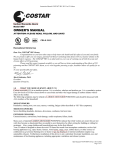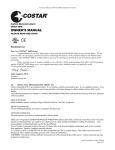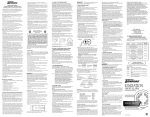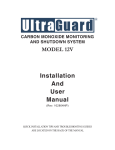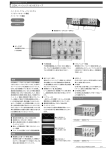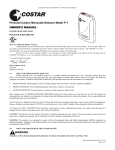Download Update Bulletin No. 503
Transcript
Update Bulletin No. 503 www.dulley.com T hank you for your interest in writing to me about CO (carbon monoxide) detectors/alarms. Do not feel that you are safe just because you live in an older house that is not very airJim Dulley tight. If you have any combustion appliances in your home, your family is at risk for CO poisoning. See the table below describing some of the common effects of various concentration levels of CO. If you ever suspect CO poisoning, leave your house immediately, contact the fire department for an inspection and contact your doctor or visit an emergency facility. On the following pages, I have listed manufacturers of various types of CO detectors/alarms. Read through their features to determine which ones fit your family’s needs. All of them produce a loud audible alarm. If someone in your house is hearing impaired, consider getting one with a visible alarm signal also. If you choose to do a test with the tablets, their useful life it limited. Check the packaging to see how long they are effective. Quantum is one of the few companies which still offer the tablets. Also check your local hardware store or call your gas utility company for local sources. On the newest detectors is the “OneLink” design by Alert. All the detectors within your home communicate with one another. When Effects of CO Exposure Concentration of CO in Air (ppm = parts per million) Approximate Inhalation Time and Toxic Symptoms Developed 35 ppm The maximum allowable concentration for continuous exposure in any 8-hour period, according to Occupational Safety and Health Association (OSHA). 200 ppm Slight headache, fatigue, nausea after 2-3 hours. 400 ppm Frontal headaches within 1-2 hours, life threatening after 3 hours, also maximum parts per million in flue gas (on an air free basis) according to EPA and American Gas Association. 800 ppm Dizziness, nausea and convulsions within 45 minutes. Unconsciousness within 2 hours. Death within 2-3 hours. 1,600 ppm Headache, dizziness and nausea within 20 minutes. Death within 1 hour. 3,200 ppm Headache, dizziness and nausea within 5-10 minutes. Death within 25-30 minutes. 6,400 ppm Headache, dizziness and nausea within 1-2 minutes. Death within 10-15 minutes. 12,800 ppm Death within 1-3 minutes. dizziness, one detector sense CO and sounds, they all sound to warn everyone in the house. They also offer a unique model which can be controlled from your television remote control unit (see below). One of the best ways to protect your family from exposure to CO is to have all your combustion appliances serviced regularly by professionals. The majority of COrelated accidents are a result of malfunctioning heating appliances. Make sure to provide adequate combustion air for all these appliances because newer homes are more airtight than older ones. Your local fire department can give you advice on this and other tips for minimizing CO hazards. Plug-in CO Alarm with Remote Control Testing by First Alert This model is a carbon monoxide alarm you can test using your television or VCR remote control. For added protection, the battery back-up powers the alarm for several hours if the electricity fails. Digital display and CO memory store levels of carbon monoxide detected to help emergency responders and technicians investigate an alarm. • Remote control test/silencer • Digital display • CO memory • 9-volt battery back-up • Temporary silence feature • Low battery warning sound • Alarm indicator light • Five-year limited warranty • Test/silence button on the unit • Plug-in electrically powered Battery-Powered CO Alarm by First Alert Simply put in the battery and the alarm is ready for use. There is no permanent installation needed. This CO alarm’s tabletop design is ideal for bedrooms, hallways and other areas where you don’t have available electrical outlets. Optional wall mount bracket included. • Low-battery warning sound • 9-volt battery powered • Alarm indicator light • Temporary silence feature • Five-year limited warranty • Test/silence button on unit Health Effects and Sources of Indoor Combustion Pollutants Pollutant Description Health Effects Sources Carbon Monoxide (CO) Colorless, odorless, tasteless gas Death at very high levels, headache, fatigue, queasiness, heart pains poor vision/concentration Malfunctioning gas appliances, improper use of gas stoves, woodburning, kerosene heaters, charcoal grills, idling cars in enclosed garages, polluted outdoor air Nitrogen Dioxide (NO2) Colorless, tasteless gas with sharp odor Lung damage, lung disease after long exposure, respiratory infections Gas stoves, malfunctioning gas appliances, woodburning, kerosene heaters, charcoal grills, motor vehicles Particles (PM 10 ) Small inhalable particles Nose, throat, eye irritation, emphysema, bronchitis, lung cancer, allergies, asthma, respiratory/ear infections Tobacco smoke, woodburning, kerosene heaters, charcoal grills, cooking, incense burning, house dust, hobbies, polluted outdoor air Organic particles and gases Lung, stomach, bladder, and skin cancer nose, throat, and eye irritation Tobacco smoke, woodburning, kerosene heaters, charcoal grills, self-cleaning ovens, incense burning, cooking, hobbies, polluted outdoor air Polycyclic Aromatic Hydrocarbon (PAHs) AM/FM Clock Radio with Carbon Monoxide Alarm by S-Tech • Voice warning on detection of CO concentration • Loud 85 decibel alarm • Instant test/ rest button • Self-diagnostic circuitry • Red LED dual-color alarm light • Sensor monitors carbon monoxide gas every 2.5 minutes, sampling air up to 40 ft. in diameter without partitions • Large green 0.9” LED clock display • Hour/minute set controls, sleep button and snooze bar, volume control • Wake-to-music or alarm • Battery back up on alarm clock function Update Bulletin No. 503 www.dulley.com page 2 Selected Manufacturers of Residential Carbon Monoxide Detectors/Alarms Manufacturer FIRST ALERT 3901 Liberty Street Road Aurora, IL 60504 (800) 323-9005 (630) 851-7330 www.firstalert.com Model FCDN3 SCO500 FCDN2 FCD4 FCD2DDN Power Source Number of Stages Type of Alarm Warranty one-stage audible and visual five-year battery 120 volt plug-in 120 volt plug-in Features - Model “FCD4" model can be tested using your TV or VCR remote control. Digital display and CO memory store levels of carbon monoxide detected. This unit also has a battery back-up that powers the alarm for several hours if the power goes out. Model “SCO500 is combination CO detector and smoke alarm. which has the communicating "OneLink" technology. The battery-operated units both use a 9-volt alkaline battery. The CO detector/smoke alarm unit has an octagonal shape and it distinguishes between smoke and CO. It activates different horn patterns and has separate lights for each. It has a low level battery indicator. There is a silencer button that temporarily quiets both alarms. Model “FCD2DDN” has digital display that will show the current CO level and you can check the highest level of CO detected since the last reading was cleared from the memory. Model “FCDN2” covers only one outlet. The "FCDN2" and the "FCDN3" both have alarm indicator lights and a silencer button to temporarily quite the unit. The "FCDN3" comes with a wall mounting bracket and has a low battery warning sound. Replacement sensor modules are available and come with a three-year warranty. See page one for features on "FCD4" and "FDCN3." KIDDE SAFETY 1394 South Third St. Mebane, NC 27302 (800) 880-6788 www.kiddeus.com KN-COSM-B Premium Plus KN-COPP-B KN-COB-DP Premium KN-COP-DP Premium Plus KN-COPP-3 battery 120 volt plug-in one-stage audible and visual five-year 120 volt plug-in with battery back-up Features - The Nighthawk “KN-COB-D" has a continuous digital display of all CO levels. The "KN-COSM-B" unit is a combination smoke alarm and CO detector with a voice alarm. The “Premium Plus” models recall and display the highest measured CO levels. The units will sound an 85 decibel alarm if the CO levels become dangerous. In the event of a power outage, the battery backup (9-volt) on the “Premium Plus KN-COPP-3” model will operate for a minimum of four hours. The test/reset button tests the unit's electronics and silences the alarms, this allows you to check the unit to see that it is functioning correctly. There is also another "Premium" model that is available with an electrical cord for ease of placement. The battery-operated detectors are round and the AC-powered units are rectangular shaped. Some models have silencer to temporarily quiet the unit. See page four for photo and features of "Premium Plus KN-COPP-B." MACURCO INC. 6555 S. Kenton St. - Suite 304 Centennial, CO 80111 (303) 781-4062 www.macurco.com CM-1B CM-15 audible and visual 120 or 240 volt two-stage CM-15A one-year visual two-years from mfg. audible and visual date stamped on unit Features - The visual display for the CM-15 and CM-15A units in normal operation will show a green light. If the levels start to elevate the light will turn to amber to show caution, hazardous conditions possible. When the CO levels are extremely high, the light will turn red to indicate dangerous levels. A loud buzzer will sound on the CM-15A model that will wake heavy sleepers. The unit is white and can be surface mounted or flush mounted. “CM-1B” is to be used as a stand-alone detector or to control another device. Unit will continuously measure the concentration level of CO and digitally display the current level every 2-1/2 minutes. If the level of CO is dangerous, the buzzer will sound indicating you should check the level. COS2000 CO1100 NORTH AMERICAN DETECTORS (AMERICAN SENSORS) 20 Steelcase Rd. W., No. 3 Markham, Ontario Canada L3R 1B2 (800) 387-4219 www.nadidistribution.com battery one-stage six year CO800 CO800EL 120 volt plug-in two-stage CO910 CO810 120 volt hardwire CO920 120 volt plug-in with battery back-up audible and visual five-year Features - Model “COS2000” is a combination carbon monoxide detector and smoke alarm. The unit has a low battery warning and it uses a 9-volt battery. There are distinct light indicators and alarm sounds for carbon monoxide and smoke so you will be able to identify the problem. Model “CO1100” works anywhere — great for traveling, wall mounting or to place on a desk or tabletop. The unit uses four AA batteries and there is a low battery warning. The two-stage units will have a flashing light at low levels and the light will be constant at high levels of carbon monoxide. All of the units sound an 85 decibel alarm when a potentially harmful level of CO is reached. Model “CO800EL” has an electroluminescent safety light. "CO910” has a digital LED display that displays CO levels above 100 ppm. Model “CO920” also has a digital LED display and the unit has a back-up power source that will provide continuous protection even if there is a power failure. The units have an instant test/reset feature that allows you to check if detector is operating correctly. QUANTUM GROUP, INC. 7737 Kenamar Court San Diego, CA 92121 (800) 432-5599 www.qginc.com COStar 9SIR battery COStar 12SIR 120 volt plug-in one-stage audible and visual six-year Features - The "COStar 9SIR" is a battery-operated unit that has a red LED light that flashes every 30 seconds to indicate unit is operating under normal conditions. There is a low battery warning. The micro-controller measures CO level every 30 seconds. "COStar 12SIR" has the same features only plugs in to an outlet. There are CO detector tablets on a card that indicate potential problems. Tablet remains yellow in normal conditions, turns green for caution, and turns dark blue at dangerous levels of carbon monoxide. See page four for picture and features of the CO tablet detectors. They also offer a Safety Shut-off System that will shut down appliances when CO reaches and unsafe level. Quantum also manufactures a CO detector for personal or vehicle use. This unit can be clipped to a belt, pocket or vehicle visor. Update Bulletin No. 503 www.dulley.com page 3 Selected Manufacturers of Residential Carbon Monoxide Detectors/Alarms Manufacturer RESEARCH PRODUCTS/APRILAIRE PO Box 1467 Madison, WI 53701 (888) 257-8801 www.aprilaire.com Model Power Source Number of Stages Type of Alarm Warranty Carbon Monoxide Detector battery one-stage audible and visual six-year Features - The alarm maintains the ability to detect carbon monoxide for up to five years. The unit will automatically alert you when it does stop working so you can immediately fix the problem. When no carbon monoxide is present a red light will flash approximately every 60 seconds. When the unit detects CO the audible signal is sounded continuously and the light will flash four times every five seconds. Research Products/AprilaireT also offers testing kits that are able to determine if your CO alarms are functioning properly. SENCO SENSORS Suite 1408, 700 West Pender St. Vancouver, B.C. Canada V6C 1G8 Hardaware and home center stores Model One battery two-stage audible and visual six-year Model 2002 Features - These electrochemical sensors have both high level and low level alerts. The units use a 9-volt battery and a low battery icon appears and an alarm beeps once a minute to let you know it is time to change the battery. The alarm are portable and can be set on a tabletop or attached to a wall. They will continue to operate in case of a power failure. On the "Model One" unit the digital readout displays the current level and peak level readings. It can recall the highest level of CO present within the past four weeks. It has one button operation — one button to test, reset, recall peak levels and to silence alarms. Model 2002 does not have a digital display. S-TECH (PATRICK PLASTICS) 18 Basaltic Rd. Vaughan, Ontario, Canada L4K 1G6 (800) 203-7987 (905) 660-9066 www.ppi-stech.com STCO-850 STCO-058 120 volt plug-in STCO 500/501 STCO 500/501 LC STCO 500/501 HWF STCO-100N COCR-015 120 volt power cord plug-in one-stage audible and visual 120 hardwire 120 volt plug-in five-year two-year audible one-year Features - The “STCO-850" has a digital read-out that shows the previous highest reading and samples the air level every 2.5 minutes. "COCR-015” is a combination carbon monoxide detector and an alarm/clock radio. This unique bedside unit wakes you in the morning while protecting you against CO poisoning. The CO alarm works when the radio is on or off. The CO alarm overrides all radio broadcasting. It gives verbal information and instructions when in CO alarm mode. It continuously tells you of the ppm levels and to exit to fresh air. Equipped with a loud piercing 85 decibel alarm. There is an instant test/reset button. The self-diagnostic circuitry is constantly checking the unit. There is a red LED dual-color alarm light. The sensor monitors carbon monoxide gas every 2.5 minutes and samples the air up to a 40 ft. in diameter room. There is large green 0.9" LED clock display, hour/minute set controls, sleep button and snooze control, volume control, wake to music or an alarm. There is a battery back up on the alarm clock function. Model “STCO-058” is self diagnostic for the electronics and has a supervisory system for the sensor. If the sensor fails, you will be alerted to the problem by the trouble signal. Model “STCO-500/501” has digital displays. There are carbon monoxide alarm testers available that are reusable and allow you to test your CO detector to see if it will actually activate in the presence of CO. See page one for photo and description of the "STCO-305" radio/alarm clock and page four for details of the "STCO-058." Seven Carbon Monoxide Checkpoints by First Alert Following these seven CO checkpoints can help families guard against carbon monoxide poisoning. (1) Forced-air Furnace • Make sure the thermostat isn’t broken, which can be indicated by a continually running furnace • Have a qualified professional check the furnace and measure the concentration of CO in the flue • Have a qualified professional inspect the combustion chamber; internal heat exchanger; the connections to flue pipes; and venting systems to the outside of the home for corrosion, rust, gaps, holes, and metal fatigue • Clear filters and filtering systems of dust and dirt • Ensure that forced-air fans and blowers are properly installed • Look at the flame in burners and ignition system to ensure the flame is not mostly yellow in color, which indicates that the fuel is not burning completely—it should be a bluish hue (2) Gas, Oil, Propane and Kerosene Appliances—water heaters, clothes dryers, kitchen ranges, ovens or cooktops, and gas refrigerators • Inspect pilot lights on gas appliances to ensure that they are not mostly yellow in color, which indicates that the fuel is not burning completely • Check oil appliances for an oily odor which can indicate that the appliances are not operating properly and can be emitting increased levels of CO • Clean out the lint and debris that build up in the clothes dryer vent leading to the outside of the house (3) Space Heaters • Ensure that all natural gas space heaters are free of dust and are vented properly (4) Barbeque Grills • Never operate barbeque grills indoors or in the garage • Do not use grills or other outdoor cooking appliances to heat a tent or camper (5) Fireplace and Wood-burning Stoves • Look at the chimneys, flues and stacks for corrosion, holes, cracks, bends, or dents; and repair any damage found • Inspect and clean any soot and debris, such as bird nests and paper, out of the chimneys, flues and stacks (6) Attached Garages • Never leave an automobile running in a garage—even for a couple of minutes and not even if the overhead garage door is open (7) CO Alarms • Install a minimum of one CO alarm outside each sleeping area, and for maximum protection install at least one CO alarm per level • Clear CO alarms of all of dust and debris • Ensure that they are plugged all the way into the outlet, or if battery operated, have working batteries installed • Make certain each person can hear the CO alarm from their sleeping room • Make sure the alarms are installed at least 15 feet away from sources of CO to reduce the number of nuisance alarms Update Bulletin No. 503 www.dulley.com CO Tablet Detector from Quantum Potential Carbon Monoxide Sources in the Home Blocked chimney opening Clogged chimney Improperly installed gas kitchen range or cooktop vent Gas clothes Operating barbecue grill dryer in enclosed area such as the garage Auto exhaust fumes from attached garage Portable heater Gas or wood-burning fireplace Corroded or disconnected water heater vent pipe page 4 Leaking chimney pipe or flue Carbon monoxide detector locations Cracked heat exchanger For maximum protection — two carbon monoxide detectors are recommended per household: one located near the sleeping area, the other outside the furnace room. Model STCO-058 Carbon Monoxide Alarm from S-Tech • Minimum 18 month sensor life. • Multi-level detection — table changes colors — yellow is normal, green is caution and dark blue is danger. • Responds to CO in a manner similar to the human body. • Rapid sensor regeneration. • Sensor protected from accidental spray of household chemicals. • Operable conditions — relative humidity range of 25 percent to 90 percent, temperature range of 41°F to 100°F. Premium Plus Carbon Monoxide Alarms from Kidde • 120 volt AC, plug-in with no installation required • No replacement sensor necessary • Advanced semi-conductor sensor technology • Detection frequency — samples every 21/2 minutes • Instant test/reset feature • Power/alarm indicators • Self-diagnostic circuitry • Loud 85 decibel alarm at 10 feet • Five-year limited warranty • Digital readout — continuous digital display of all CO levels from 0-999 ppm • Peak level memory — recalls the highest danger level • Loud 85 decibel alarm alerts you if carbon monoxide levels become dangerous • Updated digital reading — taken every 21/2 minutes lets you see if levels change • Test/reset button — tests unit’s electronics and silences sounder alarm • Five-year limited warranty • UL listed Safety Tips to Help Reduce CO Levels Blocked/clogged chimney — causes combustion byproducts, including CO. Cracked masonry can also cause a blockage. Periodic inspection and cleaning helps prevent problems. A screen cap for the top of the chimney is a good idea. Fireplaces (gas or wood burning) — Leaving the window open a few inches provides circulation of fresh air while preventing negative pressure buildup/backdrafting which can draw CO and other toxins into the home. Do not burn treated or painted wood, and scrap lumber. Burn only seasoned firewood. Before starting a fire, make sure the damper is open. Always leave the flue open even if the fire is almost out. Gas log sets, burners and ventless heaters produce a lot of CO. Some gas log sets/heaters use a sensor that shuts it down if oxygen drops to a certain level. Look for a heater with a CO safety shutoff. Kitchen ranges/stoves — are common sources of CO in a house since they are often unvented. Regular cleaning of range top, oven cavity and burners will alleviate some problems. If burners are dirty and clogged, the fuel air mixture becomes improperly adjusted causing inefficient combustion. Older appliances may have rust or damage to burner system which may cause CO. The exhaust fan over range top is sometimes unvented and does not help dissipate CO. The fan provides filtration of grease vapor and soot generated during cooking. Regular maintenance of cleaning and adjustment of the air/fuel mixture is recommended. Never warm the house using your natural gas or propane oven. Attached garage — Never warm up your car in the garage even if the garage door is open. Leave the overhead door open for at least a few minutes after you have pulled your car into the garage. Use the same precautions when using any combustion appliance — lawn mowers, snowblowers, generators, lawn tools, motorcycles, etc. Also, garages should have outside air vents. Grill barbecues and hibachis — should never be used indoors, inside the garage or on a porch or patio. The smoldering embers of charcoal produce great amounts of CO. Grill a fair distance away from the windows of your house. Water heater — is a potential source of CO. It may be faulty as purchased or installed improperly. Basement flooding may have caused dam- age to make it function inefficiently. A clogged burner, blocked vent or even the pilot light can produce CO. Danger signs that CO is being produced include a yellow burner flame and soot buildup. Regular maintenance to ensure air/fuel mixture is adjusted correctly and cleaning of the burner components is recommended. Furnace (vent, heat exchanger) — produces CO because of a mechanical failure as a result of a cracked heat exchanger, flue or burner problems. Incorrect installation, damage caused by basement flooding, and pilot lights can produce CO. A clogged or dirty burner can affect the air/fuel mixture resulting in inefficient combustion. Yellow flames and soot accumulation are indications that the furnace needs maintenance. Frequent inspection and regular maintenance of the burner, flue, and chimney is recommended. Gas clothes dryer — Damage caused by flooding and exhaust pipes clogged with lint could cause CO to buildup. The burner can become dirty or clogged and affect the air/fuel mixture. Frequent inspection and regular maintenance of the burner are good preventive measures. Also, clean the lint filter after every load of laundry. Visit www.dulley.com for a listing of all 194 Dulley Update Bulletins available to order by mail for email delivery.




